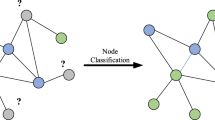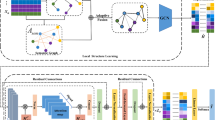Abstract
Network embedding which aims to embed a given network into a low-dimensional vector space has been proved effective in various network analysis and mining tasks such as node classification, link prediction and network visualization. The emerging network embedding methods have shifted of emphasis in utilizing mature deep learning models. The neural-network based network embedding has become a mainstream solution because of its high efficiency and capability of preserving the nonlinear characteristics of the network. In this paper, we propose Adversarial Network Embedding using Structural Similarity (ANESS), a novel, versatile, low-complexity GAN-based network embedding model which utilizes the inherent vertex-to-vertex structural similarity attribute of the network. ANESS learns robustness and effective vertex embeddings via a adversarial training procedure. Specifically, our method aims to exploit the strengths of generative adversarial networks in generating high-quality samples and utilize the structural similarity identity of vertexes to learn the latent representations of a network. Meanwhile, ANESS can dynamically update the strategy of generating samples during each training iteration. The extensive experiments have been conducted on the several benchmark network datasets, and empirical results demonstrate that ANESS significantly outperforms other state-of-the-art network embedding methods.
Similar content being viewed by others
References
Cui P, Wang X, Pei J, Zhu W W. A survey on network embedding. IEEE Transactions on Knowledge and Data Engineering, 2019, 31(5): 833–852
Perozzi B, Al-Rfou R, Skiena S. Deepwalk: online learning of social representations. In: Proceedings of the 20th ACM SIGKDD International Conference on Knowledge Discovery and Data Mining. 2014, 701–710
Tsoumakas G, Katakis I. Multi-label classification: an overview. International Journal of Data Warehousing and Mining, 2007, 3(3): 1–13
Xu X W, Yuruk N, Feng Z D, Schweiger T A. Scan: a structural clustering algorithm for networks. In: Proceedings of the 13th ACM SIGKDD International Conference on Knowledge Discovery and Data Mining. 2007, 824–833
Maaten L, Hinton G. Visualizing data using t-SNE. Journal of Machine Learning Research, 2008, 9(Nov): 2579–2605
Liben-Nowell D, Kleinberg J. The link-prediction problem for social networks. Journal of the American Society for Information Science and Technology, 2007, 58(7): 1019–1031
Lee J, Tukhvatov R. Evaluations of similarity measures on vk for link prediction. Data Science and Engineering, 2018, 3(3): 277–289
Tang J, Qu M, Wang M Z, Zhang M, Yan J, Mei Q Z. Line: large-scale information network embedding. In: Proceedings of the 24th International Conference on World Wide Web. 2015, 1067–1077
Grover A, Leskovec J. Node2vec: scalable feature learning for networks. In: Proceedings of the 22nd ACM SIGKDD International Conference on Knowledge Discovery and Data Mining. 2016, 855–864
Wang D X, Cui P, Zhu W W. Structural deep network embedding. In: Proceedings of the 22nd ACM SIGKDD International Conference on Knowledge Discovery and Data Mining. 2016, 1225–1234
Ban Y F, Pu J H, Chen Y J, Wang Y H. Negan: network embedding based on generative adversarial networks. In: Proceedings of the International Joint Conference on Neural Networks. 2018, 1–8
Wang H W, Wang J, Wang J L, Zhao M, Zhang W N, Zhang F Z, Xie X, Guo M Y. Graphgan: graph representation learning with generative adversarial nets. In: Proceedings of the AAAI Conference on Artificial Intelligence. 2018, 2508–2515
Dai Q Y, Li Q, Tang J, Wang D. Adversarial network embedding. In: Proceedings of the AAAI Conference on Artificial Intelligence. 2018, 2167–2174
Gao H C, Huang H. Self-paced network embedding. In: Proceedings of the 24th ACM SIGKDD International Conference on Knowledge Discovery and Data Mining. 2018, 1406–1415
Sang L, Xu M, Qian S, Wu X D. AAANE: attention-based adversarial autoencoder for multi-scale network embedding. In: Proceedings of the Pacific-Asia Conference on Knowledge Discovery and Data Mining. 2019, 3–14
Goodfellow I, Pouget-Abadie J, Mirza M, Xu B, Warde-Farley D, Ozair S, Courville A, Bengio Y. Generative adversarial nets. In: Proceedings of Advances in Neural Information Processing Systems. 2014, 2672–2680
Cao S S, Lu W, Xu Q K. Grarep: learning graph representations with global structural information. In: Proceedings of the 24th ACM International Conference on Information and Knowledge Management. 2015, 891–900
Yang C, Sun M S, Liu Z Y, Tu C C. Fast network embedding enhancement via high order proximity approximation. In: Proceedings of the 26th International Joint Conference on Artificial Intelligence. 2017, 19–25
Wang X, Cui P, Wang J, Pei J, Zhu W W, Yang S Q. Community preserving network embedding. In: Proceedings of the AAAI Conference on Artificial Intelligence. 2017, 203–209
Wold S, Esbensen K, Geladi P. Principal component analysis. Journal of Chemometrics and Intelligent Laboratory Systems, 1987, 2(1): 37–52
Lathauwer L D, Moor B D, Vandewalle J. A multilinear singular value decomposition. Journal of Matrix Analysis and Applications, 2000, 21(4): 1253–1278
Mikolov T, Sutskever I, Chen K, Corrado G S, Dean J. Distributed representations of words and phrases and their compositionality. In: Proceedings of Advances in Neural Information Processing Systems. 2013, 3111–3119
Lyu T S, Zhang Y, Zhang Y. Enhancing the network embedding quality with structural similarity. In: Proceedings of the 26th ACM International Conference on Information and Knowledge Management. 2017, 147–156
Cao S S, Lu W, Xu Q K. Deep neural networks for learning graph representations. In: Proceedings of the AAAI Conference on Artificial Intelligence. 2016, 1145–1152
Kipf T N, Welling M. Variational graph auto-encoders. 2016, arXiv preprint arXiv:1611.07308
Kipf T N, Welling M. Semi-supervised classification with graph convolutional networks. In: Proceedings of International Conference on Learning Representations. 2017
Velikovi P, Fedus W, Hamilton W L, Lio P, Bengio Y, Hjelm R D. Deep graph infomax. In: Proceedings of International Conference on Learning Representations. 2019
Gao H C, Pei J, Huang H. Progan: network embedding via proximity generative adversarial network. In: Proceedings of the 25th ACM SIGKDD International Conference on Knowledge Discovery and Data Mining. 2019, 1308–1316
Sun Y W, Wang S H, Hsieh T, Tang X F, Honavar V G. MEGAN: a generative adversarial network for multi-view network embedding. In: Proceedings of the 28th International Joint Conference on Artificial Intelligence. 2019, 3527–3533
Hu B, Fang Y, Shi C. Adversarial learning on heterogeneous information networks. In: Proceedings of the 25th ACM SIGKDD International Conference on Knowledge Discovery and Data Mining. 2019, 120–129
Yu W C, Zheng C, Cheng W, Aggarwal C C, Song D J, Zong B, Chen H F, Wang W. Learning deep network representations with adversarially regularized autoencoders. In: Proceedings of the 24th ACM SIGKDD International Conference on Knowledge Discovery and Data Mining. 2018, 2663–2671
Chang L J, Li W, Lin X M, Qin L, Zhang W J. Pscan: fast and exact structural graph clustering. In: Proceedings of the 32nd IEEE International Conference on Data Engineering. 2016, 253–264
Yang C, Liu Z Y, Zhao D L, Sun M S, Chang E Y. Network representation learning with rich text information. In: Proceedings of the 24th International Joint Conference on Artificial Intelligence. 2015, 2111–2117
Acknowledgements
This work was supported by the National Key R&D Program of China (2018YFB1003404), the National Natural Science Foundation of China (Giant Nos. 61872070, U1811261), the Fundamental Research Funds for the Central Universities (N171605001) and Liao Ning Revitalization Talents Program (XLYC1807158).
Author information
Authors and Affiliations
Corresponding author
Additional information
Zihan Zhou received the Master degree from Northeastern University, China in 2020. His research interest is network embedding.
Yu Gu received the PhD degree in computer software and theory from Northeastern University, China in 2010. Currently, he is a professor and the PhD supervisor at Northeastern University, China. His current research interests include big data analysis, spatial data management and graph data management. He is a senior member of the China Computer Federation (CCF).
Ge Yu received the PhD degree in computer science from Kyushu University, Japan in 1996. He is currently a professor and the PhD supervisor at Northeastern University, China. His research interests include distributed and parallel database, OLAP and data warehousing, data integration, graph data management, etc. He is a member of ACM, a senior member of IEEE, and a Fellow of the China Computer Federation (CCF).
Electronic Supplementary Material
Rights and permissions
About this article
Cite this article
Zhou, Z., Gu, Y. & Yu, G. Adversarial network embedding using structural similarity. Front. Comput. Sci. 15, 151603 (2021). https://doi.org/10.1007/s11704-020-9182-1
Received:
Accepted:
Published:
DOI: https://doi.org/10.1007/s11704-020-9182-1




